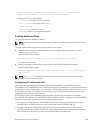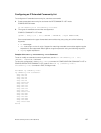Filtering Routes with Community Lists
To use an IP community list or IP extended community list to filter routes, you must apply a match
community filter to a route map and then apply that route map to a BGP neighbor or peer group.
1. Enter the ROUTE-MAP mode and assign a name to a route map.
CONFIGURATION mode
route-map map-name [permit | deny] [sequence-number]
2. Configure a match filter for all routes meeting the criteria in the IP community or IP extended
community list.
CONFIG-ROUTE-MAP mode
match {community community-list-name [exact] | extcommunity extcommunity-
list-name [exact]}
3. Return to CONFIGURATION mode.
CONFIG-ROUTE-MAP mode
exit
4. Enter ROUTER BGP mode.
CONFIGURATION mode
router bgp as-number
AS-number: 0 to 65535 (2-Byte) or 1 to 4294967295 (4-Byte) or 0.1 to 65535.65535 (Dotted format)
5. Apply the route map to the neighbor or peer group’s incoming or outgoing routes.
CONFIG-ROUTER-BGP mode
neighbor {ip-address | peer-group-name} route-map map-name {in | out}
To view the BGP configuration, use the show config command in CONFIGURATION ROUTER BGP
mode. To view a route map configuration, use the
show route-map command in EXEC Privilege mode.
To view which BGP routes meet an IP community or IP extended community list’s criteria, use the show
ip bgp {community-list | extcommunity-list}
command in EXEC Privilege mode.
Manipulating the COMMUNITY Attribute
In addition to permitting or denying routes based on the values of the COMMUNITY attributes, you can
manipulate the COMMUNITY attribute value and send the COMMUNITY attribute with the route
information.
By default, the system does not send the COMMUNITY attribute.
To send the COMMUNITY attribute to BGP neighbors, use the following command.
• Enable the software to send the router’s COMMUNITY attribute to the BGP neighbor or peer group
specified.
CONFIG-ROUTER-BGP mode
neighbor {ip-address | peer-group-name} send-community
188
Border Gateway Protocol IPv4 (BGPv4)


















